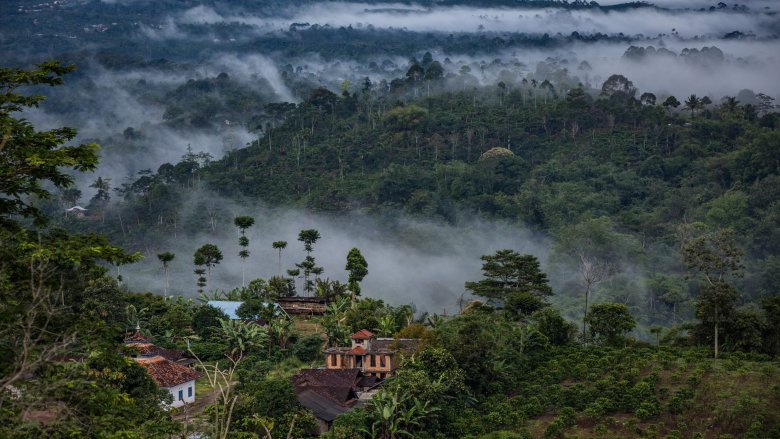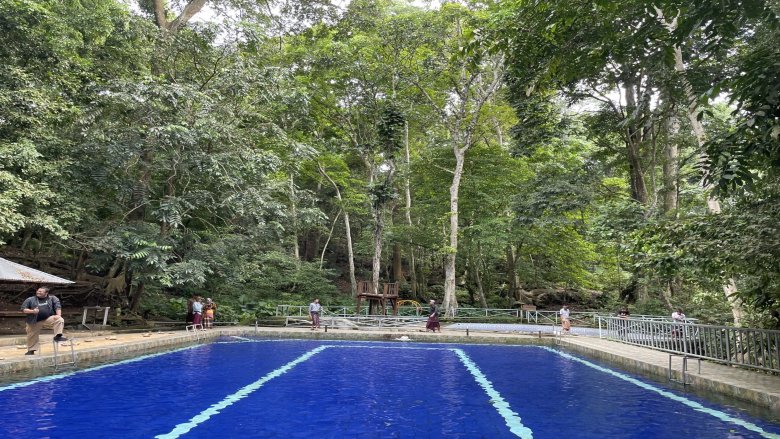Once he was chased by officers for illegal logging; now he is pursued by buyers eager to purchase his sustainable honey. Bapak Suryanto, now holds a “cultivator card” from the Rinjani Barat Forest Management Unit (FMU) in West Nusa Tenggara province in Indonesia’s Lesser Sunda Islands. The card is proof that Bapak Suryanto holds a social forestry license, granting him and other farmers legal access to forest areas for sustainable livelihood activities such as agroforestry (e.g. coffee, eucalyptus).
Living nearby is Ibu Denda, a development economics graduate and a member of an Indigenous community who has long sought ways to protect forests while also preserving sources of income for the community she calls home. A World Bank-supported project, the Forest Investment Program II (FIP II), has made it possible for her to work with local, regional, and national agencies to develop an ecotourism scheme and rehabilitate a natural pool as a tourist destination within the forest.
"With the support of the FIP II Program, the number of visitors to the natural bathing area within Mandala Traditional Forest increased by 50 percent,” she said. “This has benefited our economy.”
Community pool within the forest as a tourist destination.
Four Lessons for Making Indonesia’s Forests Net Carbon Sinks
Bapak Suryanto and Denda’s efforts, and others like theirs, are critical for Indonesia to make progress in reducing emissions from the forest and land use (FOLU) sector. The sector has historically been responsible for over 40 percent of the country’s emissions through deforestation and fire. But just as these activities cause release of carbon into the atmosphere, intact trees and forests absorb carbon – effectively acting as a sink to drain carbon from the air.
Accordingly, the Indonesian government has committed to fostering forest and land use practices that on balance absorb more carbon than is emitted, by 2030. Known as the “FOLU net sink target,” this objective is part of Indonesia’s Enhanced Nationally Determined Contribution (NDC) which aims to reduce greenhouse gas emissions by 32 percent, or to 43 percent with international assistance, relative to business as usual, by 2030. In addition to reducing emissions, sustainable forest management activities are also intended to improve communities’ livelihoods.
Since 2016, the World Bank has been supporting the Government’s transition toward low-carbon, resilient, biodiverse, and prosperous landscapes in Indonesia through Indonesia’s Sustainable Landscape Management Program (SLMP). The program’s experience and accomplishments yield four important lessons.
First, strong government leadership is essential, particularly at the local level. The national-level Long-Term Strategy for Low Carbon and Climate Resilience 2050, the nationally determined contribution and the forest and land use carbon sink objective will need to be translated to the provincial level. In West Nusa Tenggara province, for instance, the provincial government has put environmental conservation at the core of provincial development by elaborating it in their mid-term development plan, which serves as a reference for protecting forests while also improving livelihoods and the local economy. The provinces of Jambi and East Kalimantan are similarly leading the way through their development of Green Growth Plans.
Second, decentralized management of forests is key to balancing forest protection with local economic activity. In 2010, the Ministry of Environment and Forestry (MoEF) established forest management units (FMUs) as institutions to deliver national policy goals, and balance economic and environmental priorities at the local level. In places where they have been operationalized to date, they have enabled community-based development in and around forest areas, ensuring local communities have a stake in the protection and utilization of forests.
The World Bank-supported FIP II project was instrumental in piloting and operationalizing the FMU model. Through the project, which has been funded by the Climate Investment Funds (CIF) and implemented by the MoEF since 2016, ten FMUs in eight provinces across Indonesia have established partnership with communities, including 95 forest farmer groups. These FMUs are governed by sustainable long-term forest management plans, supported by benefit-sharing and conflict-resolution mechanisms to ensure continued support from communities.
To date, over 110,000 direct beneficiaries (30 percent of whom are female and 15 percent of whom are from Indigenous communities) have participated in FIP II project activities, reaping monetary and non-monetary benefits such as access to e-learning, facilitation of agroforestry model development, and skills in sustainable forest management.
Third, land tenure security for local communities and indigenous peoples is critical for forest protection and livelihoods. Lack of secure land rights leaves Indigenous Peoples and local communities vulnerable to displacement, land conflicts, and reduced livelihood opportunities – and often leads to deforestation. Given the well-documented evidence of Indigenous Peoples’ and local communities’ importance as forest guardians, legal recognition of their existence and land helps to protect forests, which is critical to mitigating and adapting to climate change.
Another World Bank-supported project, also financed by the CIF, is the Strengthening Rights and Economies of Adat and Local Communities Project (also known as the Dedicated Grant Mechanism Indonesia). This has supported Indigenous peoples and local communities in achieving legal access to land.
The project established a national steering committee to represent Indigenous Peoples and local communities from seven regions across Indonesia and helped accelerate recognition of over 2 million hectares of customary area which refers to land associated with customary rights and laws. It has further facilitated designation of over 180,000 hectares of customary forest (forests that are located within the living areas of the indigenous peoples) and social forestry areas (areas allocated by the government for sustainable forest utilization by local communities) in 51 communities.
This legal recognition of land rights needs to be coupled with efforts to increase the values of healthy forests ecosystems to the livelihoods and wellbeing of communities. Payments for ecosystem services could reward communities for undertaking actions that increase the provision of ecosystem services such as water purification, flood mitigation, or carbon sequestration.
Finally, there is a need to tailor solutions to respond to different challenges across land uses. While there are some common prerequisites for sustainable forests – including building and strengthening institutions, land rights, and leadership – community-by-community trust-building and secure financing for the long term are also needed. The FOLU Net Sink program and the model of local forest management units provide a guiding approach to implementing local-level solutions that enable provinces and districts to maintain forest cover and reduce pressures in ways suited to their local circumstances.
With these lessons in mind, Indonesia can continue to improve the livelihoods of people like Bapak Suryanto and Ibu Denda while also reducing greenhouse gas emissions and protecting biodiversity across the country.


